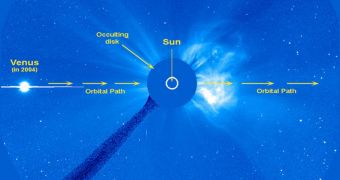Officials with the European Space Agency (ESA) announce that all suitable spacecraft at their disposal are currently ready to observe the transit of Venus, which will occur between June 5-6. The assets that are expected to yield the most significant data are Venus Express and Proba-2.
ESA is also a contributing partner in other space missions, such as the Hubble Space Telescope, the Solar and Heliospheric Observatory (SOHO), and Hinode. All these spacecraft, and many others around the world, will be trained on the rare event.
At this moment, the agency has a privileged position among similar organizations, since it's the only one to operate a functional orbiter around Venus. Data collected by this spacecraft will be essential for all other telescopes, since they will use the information to calibrate their instruments.
In addition to fulfilling this role, Venus Express will also conduct a thorough analysis of the atmosphere around our neighboring worlds. Sunlight will backdrop the planet, filtering through the atmosphere all the way to the orbiter's position, and carrying with it data on the chemicals in the air.
Since the instruments aboard the vehicle are extremely precise, they will then be used as reference points for other, larger telescopes, which will observe the atmosphere from Earth's surface or orbit.
By using this experiment as a starting point, astronomers may soon be able to develop new technique for analyzing the atmosphere of extrasolar planets, of which more than 2,300 candidates have already been identified.
Most of these worlds were discovered as they passed in between their stars and the NASA planet-hunting Kepler Telescope. The instrument uses the planetary transit method for identifying its targets.
The ESA Proba-2 microsatellite will also observe the transit from low-Earth orbit, contributing to the data collection effort. “This is important for space weather studies that help us to understand the Sun and its influence on Earth,” Joe Zender says.
“Proba-2 is expected to see a dip in the solar brightness as soon as the thick atmosphere of Venus makes first contact with the solar disc, which is an important measurement for exoplanet scientists,” adds the official, who is the Proba-2 mission manager at ESA.
After this solar transit, Venus will not perform another one until December 2117, and then December 2125. Its last transit was in 2004.

 14 DAY TRIAL //
14 DAY TRIAL //